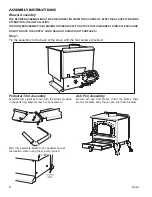
14
3.3
Stove placement / clearance requirements
This stove must only be installed onto floors with an adequate load-bearing capacity. If an existing
construction does not meet this requirement, suitable measures (e.g., load distributing plate) must
be taken.
Must be in accordance with National Laws, Building Regulations & any Rules in
Force, including BS 8303 and BS EN 15287-1:2007.
Wooden floor protection for Panther SE
The product can be placed directly onto a wooden floor providing that it is covered by a metal plate
or other suitable, non-combustible material. The minimum thickness is 12mm. Any flooring made of
combustible material, such as linoleum, carpets, etc. must be removed from under the floor plate.
Requirements for protecting combustible flooring below, in front, rear & sides of the stove
must be
in accordance with National Laws, Building Regulations & any Rules in Force, including BS 8303 and
BS EN 15287-1:2007.
Important:
This applies for free standing installations only, if the stove is fitted into a conventional class 1
chimney a constructional and superficial hearth is required and must be in accordance with
National
Laws, Building Regulations & any Rules in Force, including BS 8303 and BS EN 15287-1:2007.
See:
Figure 2 and 2A.
Panther SE stove fixing to hearth and constructional hearth
Refer to current National Laws, Building Regulations & any other Rules in Force, including British
standard BS EN 15287-1:2007 and BS 8303
Distance to wall made of combustible material
(see figure 2)
Refer to current National Laws, Building Regulations & any other Rules in Force, BS 8303 and BS EN
15287-1:2007. Contact your local building authority regarding restrictions and installation
requirements.















































